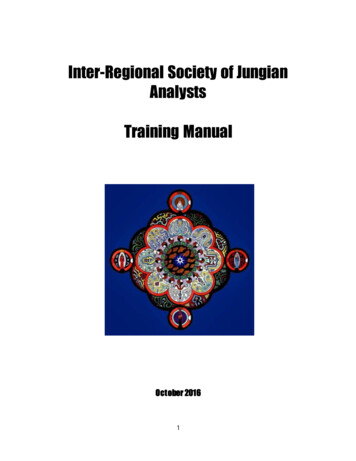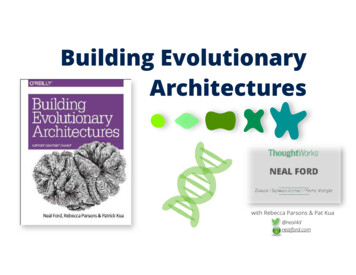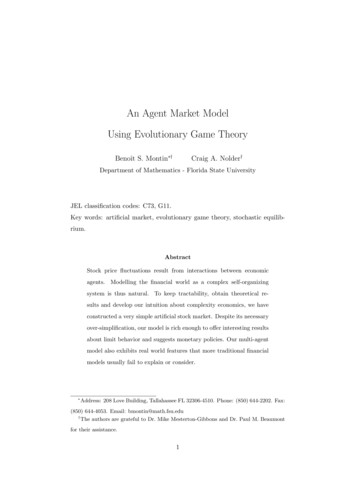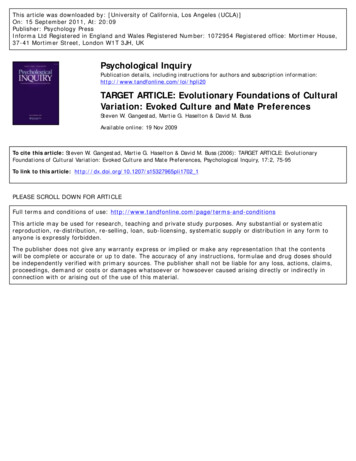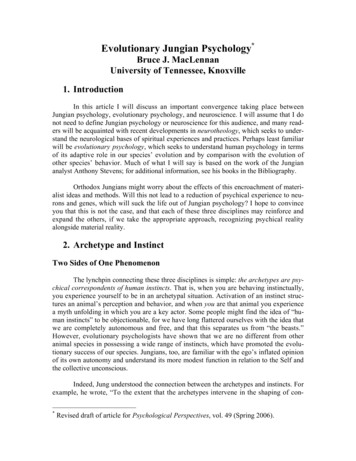
Transcription
Evolutionary Jungian Psychology*Bruce J. MacLennanUniversity of Tennessee, Knoxville1. IntroductionIn this article I will discuss an important convergence taking place betweenJungian psychology, evolutionary psychology, and neuroscience. I will assume that I donot need to define Jungian psychology or neuroscience for this audience, and many readers will be acquainted with recent developments in neurotheology, which seeks to understand the neurological bases of spiritual experiences and practices. Perhaps least familiarwill be evolutionary psychology, which seeks to understand human psychology in termsof its adaptive role in our species’ evolution and by comparison with the evolution ofother species’ behavior. Much of what I will say is based on the work of the Jungiananalyst Anthony Stevens; for additional information, see his books in the Bibliography.Orthodox Jungians might worry about the effects of this encroachment of materialist ideas and methods. Will this not lead to a reduction of psychical experience to neurons and genes, which will suck the life out of Jungian psychology? I hope to convinceyou that this is not the case, and that each of these three disciplines may reinforce andexpand the others, if we take the appropriate approach, recognizing psychical realityalongside material reality.2. Archetype and InstinctTwo Sides of One PhenomenonThe lynchpin connecting these three disciplines is simple: the archetypes are psychical correspondents of human instincts. That is, when you are behaving instinctually,you experience yourself to be in an archetypal situation. Activation of an instinct structures an animal’s perception and behavior, and when you are that animal you experiencea myth unfolding in which you are a key actor. Some people might find the idea of “human instincts” to be objectionable, for we have long flattered ourselves with the idea thatwe are completely autonomous and free, and that this separates us from “the beasts.”However, evolutionary psychologists have shown that we are no different from otheranimal species in possessing a wide range of instincts, which have promoted the evolutionary success of our species. Jungians, too, are familiar with the ego’s inflated opinionof its own autonomy and understand its more modest function in relation to the Self andthe collective unconscious.Indeed, Jung understood the connection between the archetypes and instincts. Forexample, he wrote, “To the extent that the archetypes intervene in the shaping of con*Revised draft of article for Psychological Perspectives, vol. 49 (Spring 2006).
MacLennan: Evolutionary Jungian Psychologyscious contents by regulating, modifying, and motivating them, they act like the instincts”(CW 8, ¶404), and, “The hypothesis of the collective unconscious is no more daringthan to assume that there are instincts” (CW 9, pt. 1, ¶91).To reiterate, the instincts tune perception and behavior in order to fulfill somepurpose important to our species, be it mating, infant care, cooperation, social organization, defense, or competition for mates. When an appropriate releasing stimulus activatesthe instinct, you may feel you are living a myth or that you are possessed by a spirit withits own agenda. To take an obvious example, that almost everyone will recognize, whenyou are stricken by love, you may feel as though Aphrodite or Eros is governing your behavior; your perception of the beloved will be transformed, and they will appear numinous and divine; indeed, all of life may be experienced in a magical or uncanny light.Evolution and the InstinctsEthology is the discipline that studies animal behavior in the context of its evolutionary development; that is, it seeks to understand how a species’ instincts have evolvedin interaction with its historical environment, and how they have promoted the survival ofthe species in that environment. The basis of ethology is the recognition that an instinctmust be understood in terms of a species’ environment of evolutionary adaptedness, thatis, the environment in which it has evolved and to which that instinct has served to adaptthe species. This is the context in which we may explain the purpose of an instinct (thatis, its adaptive function). (For these reasons, many evolutionary psychologists refer toevolved mechanisms or adaptations rather than “instincts.”) Therefore, to understand thepurpose (adaptive function) of the archetypes (as the psychical correlates of the instincts)we must consider Homo sapiens’ environment of evolutionary adaptedness.Konrad Lorenz (1903–89) was the founder of ethology, and Stevens (2003, 28–9)observes that Lorenz and Jung can be considered complementary, for Lorenz focused onexternal behavior, whereas Jung focused on internal experience. Of course there are otherdifferences. Jung was more interested in people, Lorenz in non-human animals. Also, Lorenz and other ethologists are interested in placing behavior in its evolutionary context,whereas Jung was not so interested in this (a perspective offered by evolutionary psychology). Finally, contemporary neuroethologists are interested in the neurological substrates of behavior and how brains have evolved, whereas Jung abandoned neurology andmost Jungians have avoided it (perhaps in reaction to the prevalent reductionist materialism of our time).Therefore, in addition to their interior aspect, which is well-known from Jungianpsychology, the archetypes have an exterior aspect when they manifest in behavior, andthe exterior aspect is especially relevant as functional (purposeful, adaptive) behavior inthe human environment of evolutionary adaptedness.Thus, instincts, understood in their evolutionary context, provide us another perspective (an exterior perspective) from which to understand the archetypes. We can explore how these instincts have been adaptive in our environment of evolutionary adapted--2-
MacLennan: Evolutionary Jungian Psychologyness, and we can investigate similar instincts in related species (e.g., nonhuman primates)and how they relate to their environments. Since a species’ instincts have evolved in theirenvironment of evolutionary adaptedness, this is the environment in which the functionof those archetypes is easiest to understand. Therefore, if we want to understand thefunction of the archetypes, and thereby gain a better understanding of their structure, thenwe should look to the environment of evolutionary adaptedness of Homo sapiens.Modern humans (Homo sapiens sapiens) are believed to have evolved about200,000 years ago in Africa. Further, as Stevens (1993, 67) observes, we have spentabout 99.5% of that time as hunter-gatherers, until animal husbandry and agriculture began to appear about 10,000 years ago. In evolutionary terms this is not much time, so genetically we are very similar to our hunter-gatherer ancestors. That means that our environment of evolutionary adaptedness is the same as theirs, and therefore that our instinctsand archetypes are essentially the same as those of paleolithic hunter-gatherers.Based on studies of contemporary hunter-gatherer societies, Stevens (1993, 67)has outlined the characteristics of human society throughout most of our history, and sothe sort of life to which we would expect our instincts and corresponding archetypes to beadapted. Comparisons with closely related primate species also add to a behavioral understanding of the instincts, which complements the interior structure described inJungian psychology and evident in myths and dreams. Stevens observes that huntergatherer groups typically contain 40 to 50 interrelated individuals, of whom six to ten areadult males, ten to twenty adult females, and the remainder juveniles. Sexual relationsare not necessarily monogamous. Such groups spend much of their time in isolation, butencounter other similar groups from time to time, which may lead to fighting or exogamous mating.One of the dilemmas facing modern humans is that our contemporary environment is very different from our environment of evolutionary adaptedness. Therefore thearchetypes that served us well through nearly 200,000 years of hunting and gatheringmay not fit so well with contemporary culture and lifestyles. As will be explained later,part of the goal of individuation is to achieve a reconciliation and accommodation between our contemporary lives and our genetic heritage, represented in the Self.Neuropsychology of the ArchetypesJust as the various physiological processes are functions of our organs as they develop in a normal environment, so human instincts and the corresponding archetypes arerooted in our bodies, but primarily in the brain as it develops in a normal environment.Although there is individual variation, the brain’s gross anatomy as well as its detailedorganization are the same for all people; so also the archetypes are common to all people,which is why we can speak of a collective unconscious and an objective psyche.Nevertheless, it is unlikely that we will discover a simple relationship between thearchetypes and brain structures (as is sometimes suggested by evolutionary psychologists’ use of such terms as “mental organ” or “module”). If we think of an archetype,-3-
MacLennan: Evolutionary Jungian Psychologysuch as the Mother archetype, it will be apparent that it depends on many brain systems:perceptual, emotional, motivational, attentional, learning and memory related, and soforth. Thus, the neural structures subserving an archetype will extend through many regions of the brain, from the brain-stem to higher cortical areas. Furthermore, as Jung emphasized in his later writings, archetypes are dynamic structures, not static images; therefore we can expect different brain systems to be involved in different phases of an archetype’s activation. Eventually, with more and improved imaging studies and with adeeper overall understanding of the brain, we may be able to chart all of the brain regionssubserving an archetype, but that time is well in the future. Nevertheless, in the meantimeeven a partial understanding of the neurological substrate of the archetypes will improveour understanding of them.It may be worthwhile to emphasize that the archetypes, even as dynamical structures, are not fixed throughout an individual’s life; that is, the dynamical structures restructure through time according to a developmental program. The first archetype to develop is, perhaps, a generalized Parent archetype, which soon becomes more specific asthe nascent Mother archetype; later, the Father archetype is differentiated, and so forth.Adolescence accelerates development of some archetypes and causes a general reorganization of them all. This is consistent with what we know about the development of thebrain, which develops rapidly into the mid-20s, but continues to transform itself thereafter (menopause being an obvious example). The old dogmas about the cessation of neuron growth are slowly collapsing, and every year brings new evidence of the brain’splasticity throughout life. Therefore, although the archetypes (as abstract structures) areeternal and unchanging, our relationships with them mature along with our bodies. Amiddle-aged man experiences Eros differently than does an adolescent boy.Even the developmental change in the brain that has been longest acknowledged— neuron death — should be understood more broadly than “the inevitable decline of oldage.” We now know that programmed neuron death (neuronal apoptosis) is an importantmechanism in the brain’s self-organization (which takes place in interaction with the environment). The unborn infant’s brain grows many more neurons than it needs, and in acompetitive process known as “neural Darwinism” it organizes, tunes, and optimizesconnections by eliminating approximately half of its neurons in a process that begins inthe final trimester and continues for several years. There is another spurt of neural growthshortly before puberty, followed by another wave of competitive elimination continuingwell into the 20s. This demonstrates that neuron death is not always a bad thing, that itmay serve a useful organizational function (rather like weeding a garden or pruning atree), and that even the gradual neuron loss of our adult years may serve some adaptivefunction. In any case, it is apparently an inevitable part of the human life cycle, and therefore the corresponding changes in our relationships with the archetypes are also a part ofour life cycle, changes that lie along our paths to individuation.Genetic variation among individuals, as well as differing environmental influences during development, will cause the archetypes to be a little different for each of us.Nevertheless, there is overall similarity among us, which is why we can speak of a collective unconscious comprising the archetypes. However, in addition to the developmen--4-
MacLennan: Evolutionary Jungian Psychologytal processes that I have mentioned, it’s important to keep in mind that learning extendsand modulates the dynamical processes governed by the archetypes, and in this way theymay become much more individual, that is, they may engender personal complexes. I willreturn to this issue later.The Human Genome and the Objective PsycheNow I would like to turn the discussion toward each individual’s genotype, thatis, the abstract sequence of approximately 300 million base pairs (A, C, G, T) that definesa person’s genetic makeup. When encoded in the DNA of a fertilized egg, this sequencegoverns (in interaction with the environment) the development of the organism, includingits brain. Therefore, the seed from which grow the archetypes, as you experience them,resides in your genotype. Your genotype corresponds precisely to a number of approximately 180 million digits, and in principle a person genetically identical to you could becreated using this number (it has been done already for viruses). Therefore this number isthe seed of your archetypal universe and each of us has such a number, an idea with connections to ancient Pythagoreanism (MacLennan, 2005). (Your number can be stored in75 MB, and so the numbers of you and eight of your friends can be stored on a CDROM!)I hope that it is clear that I am not defending a simplistic genetic determinism.Your genotype is the seed of your archetypal universe, but only the seed; just as the sameacorn in a different environment would produce a different tree, so also your archetypaluniverse is an ongoing complex unfolding of that genotypic seed in interaction with yourenvironment (including, especially, other humans).I should also forestall another simplistic interpretation of the genetic basis of thearchetypes, and that is that there is a simple relationship between archetypes and genes.Just as each archetype involves many parts of the brain, so we should expect each archetype to depend on many genes, and that each gene may affect many archetypes. This is infact the case for most genetically based traits. Therefore, it is unlikely we will find agene, or a set of genes, that corresponds directly to the Mother archetype, for example.In the foregoing I have stressed how each person’s genotype is the seed of theirarchetypal universe, which may vary from person to person with their genotype and environment. As a consequence we may seem to have lost our grasp on the collective unconscious, which is collective by virtue of being shared by all people, and on the objectivepsyche, which is objective by virtue of exhibiting the same structure to any trained observer. However, despite our individual differences, we all have recognizably humanbodies, faces, stomachs, brains, etc.; that is, our similarities are much greater than our differences, and we explain the commonalities of our bodies and behaviors by reference tothe human genome. But here we must be careful.On the one hand, there is a temptation to think of the human genome as the genetic code of the archetypal human (the Neoplatonic or Gnostic Anthropos, of whichJung wrote), and there is some merit in that correspondence. On the other, it suggests the-5-
MacLennan: Evolutionary Jungian Psychologynotion that there is an ideal Homo sapiens, of which we are all imperfect reflections, anotion which biologists have rejected for good reasons. Rather, biologists understand thehuman genome to be more like a statistical average of all the human genotypes in existence (that is, embodied in living people) at a given time. As a consequence, the humangenome changes as the population of embodied genotypes changes, and this is how species evolve. Therefore, for the same reasons, the collective unconscious, as the sum-totalof the human archetypes, should be considered a kind of average of all of our individualarchetypal universes. Just as there is an objective human body, so there is an objectivehuman psyche, the collective unconscious, comprising the human archetypes, but it existsonly by virtue of our individual archetypal universes grounded in our individual genotypes.As individuals are born and die, genotypes come into embodiment and pass out ofit. Therefore, the genome, as a sort of average of all the embodied genotypes, changesthrough time. To be sure, this is a slow process; the human genome has not changedmuch over the last 200 thousand years, which is what we mean when we say that modernhumans evolved about 200 thousand years ago. Therefore, within this time frame the archetypes have changed very little; in practical terms, they are eternal. Nevertheless, thegenome does evolve, and E. O. Wilson has estimated there can be a significant change inhuman nature in about 100 generations. Therefore, as the archetypes evolve, we can expect important changes over this time scale (which is, incidentally, not very differentfrom the nominal length of an astrological aeon: 2200 years).Certainly the archetypes will differ among individuals, just as their faces andhearts do, a consequence of genetic variation and environmental difference, while stillretaining the commonality that makes them a human face or human heart; so also, in spiteof genetic variation, there is a human Self.Perhaps the most significant difference in human experience of the archetypes isthat between men and women. The difference between genotypes with XX chromosomesand those with XY chromosomes leads to sexual dimorphism, that is, the two principlepsychosomatic patterns, male and female, for Homo sapiens and many other species.Sex-linked genes affect many characteristics of the developing body, including its brain,and so for humans, as for other animals, there are innate sexual differences in the instincts and therefore in the archetypes.3. Reductionism’s Slippery Slope?Jungians may be justifiably suspicious of attempts to reduce the archetypes andpsychical experience to neuroscience, which runs the risk of diminishing the reality ofboth. They may fear that the lived reality of dreams, numinous experiences, synchronisticevents, soulful encounters, active imagination, and so forth will be replaced by abstractmathematical formulas describing quantities of chemicals and electrical currents in microscopic neurons (if not other physical abstractions even further removed from humanexperience). There is certainly a danger of straying onto a slippery slope leading from thearchetypes, to the brain, to DNA, to abstract genes. Committed reductionists will applaud-6-
MacLennan: Evolutionary Jungian Psychologythis trajectory, but I do not think it is either desirable or necessary. How can it beavoided?First, as already remarked, we are very far from being able to explain the richdepths of the archetypes in neurological terms. Of course, this inability presents its owndanger, because committed reductionists, faced with their failure to reduce the livingrichness of some phenomenon to materialist formulas, may simply deny the reality ofthose aspects that they cannot reduce (or consign them to the scientific no-man’s land of“the subjective”). It has happened many times (a textbook example being Newton’s reduction of color to wavelength, against which Goethe argued unsuccessfully).The solution, I believe, is to hold fast to the phenomena. The ultimate ground ofall our judgments of reality is our lived experience (for this is empiricism in its most fundamental sense), and so the reality of our psychical experiences cannot be undermined bytheoretical judgments that are ultimately built upon them. Our archetypal experiences,dreams, visions, and other psychical events must be taken as real phenomena (literally,“things that appear”). The meaning of them may be amplified, but should never be replaced, by understanding derived from neuroscience or evolutionary biology.Indeed, the insights afforded by Jungian psychology need not just coexist withneuroscience and evolutionary psychology, but these insights may contribute to them inimportant ways. For example, evolutionary psychology, perhaps because of its connections to nonhuman ethology, tends to focus on behavior rather than experience. Thus, forexample, when evolutionary psychology is applied to religious phenomena, it may produce valuable insights into the adaptive function of religious behavior, but it has had littleto say about religious or spiritual experience.Fortunately the recognition of the connection between the archetypes and the instincts provides the vehicle for bringing together the phenomenological and behavioralperspectives on human psychology. On the one hand, Jungian psychology provides phenomenological and analytical tools for exploring the instincts from their psychical side.On the other, neuroscience allows us to understand the material processes underlying thearchetypes, and evolutionary psychology reveals their adaptive significance. Each sidemay suggest hypotheses and explanations to the other.From the perspective of Jungian psychology, we should not fear this encounterwith neuroscience and evolutionary psychology; rather we should embrace it. We havetwo opposed perspectives on human nature. Jungians recognize the danger of the reductionist materialist juggernaut, which threatens to destroy all forms of understanding butits own. On the other hand, in other times and places, we know that the material embodiment of the soul has been neglected, to the detriment of our understanding of both thebody and the soul. Attempting to replace either side by the other is a mistake. In thesecases, as Jung has shown, we need to embrace the opposites and accept them both, uniting them in our symbolical structures. In this way we may transcend the differences andbuild a higher unity.-7-
MacLennan: Evolutionary Jungian Psychology4. Specific Archetypes and ComplexesIn this section I will discuss some specific archetypes and complexes in order toshow how neuroscience and evolutionary psychology can extend our understanding ofthem.ArchetypesThe SelfFirst we may consider the Self, which comprises all the archetypes; that is, it is thetotality of the archetypal universe. From the external side, you can see that the Self corresponds to the full range of human instincts, which has its foundation in the human genome. That is, the genome encodes the “seed” from which the Self develops.The genome of any species defines its characteristic life cycle, which is fitted toits environment of evolutionary adaptedness. Therefore also, the human genome definesthe archetypal life cycle of all of us, which we may realize in our individual lives, moreor less. Further, the genome, as manifest in the diversity of embodied genotypes, is thefoundation for the future evolution of our species. This “phylogenetic destiny,” encodedin the genome, manifests psychically as the Self, which has its own agenda for our lives,as most of us eventually discover. The archetypes activate and intervene in our lives inoften surprising ways.Thus we may view from an evolutionary and genetic perspective the process ofindividuation, the process of becoming psychically undivided, or, as I would put it, ofacquiring primary integrity. Since the genome defines, in the most fundamental biological sense, what it is to be human, so also the Self defines human experience insofar as itis universal and (practically) eternal, rather than individual. Nevertheless, within thisshared human destiny, our individual destinies differ somewhat, as do our genotypes, andso our individual Selves differ somewhat as images of the universal Self. We become individuated by consciously articulating and reconciling our individual lives and destinieswith the destiny of our species, and in this way we bring transpersonal meaning into ourlives by living them in the context of universal humanity. We thereby become consciousparticipants in the future evolution of humankind.As is well known, the archetypes correspond to the gods of the various polytheistic pantheons, and, although I will be unable to discuss evolutionary neurotheology in anydetail in this article, it will be worthwhile to consider this perspective. By transferringresults from our evolutionary perspective on the archetypes to the gods, we may concludethat, although they are practically universal and eternal, in fact they present a slightly different face to each of us (growing out of genotypic variation), and they change (evolve)slowly through the ages, on the time scale of thousands of years. Indeed, the evolutionaryperspective helps us to understand the nature of the gods, for the human genome, andtherefore the gods, have not changed much over the past 200 thousand years. Further,since we have spent 99.5% of that time as hunter-gatherers, it is reasonable to conclude-8-
MacLennan: Evolutionary Jungian Psychologythat the gods, whose nature is encoded in our genome, are the gods that have promotedthe survival and flourishing of paleolithic hunter-gatherers living in the social groups already described. This reveals the great challenge facing modern humankind (and thecause of many of civilization’s discontents), for we are post-modern informationindustrialists living in a global megalopolis comprising billions of individuals, yet stillliving under “divine laws” suited to paleolithic hunter-gatherers! Arguably, this is whyindividuation is an imperative for us, even if it wasn’t for our paleolithic ancestors.The ShadowThe Shadow, of course, is very important, but we must distinguish the ArchetypalShadow from the Shadow Complex that grows up around it. (In this it is like most otherarchetypes, which engender one or more complexes that develop around them as an archetypal core.) The Archetypal Shadow corresponds to instinctive aversions to certainbehaviors. These would be behaviors that have been relatively maladaptive in our environment of evolutionary adaptedness. The most often cited example of such a behavior isincest, which has an obvious deleterious effect on the inclusive fitness of a group undermost circumstances. Therefore, it is reasonable to suppose that incest is a component ofthe Archetypal Shadow (although some anthropologists disagree). Apparent cultural universals (e.g., xenophobia and aggression) can often provide clues to the nature of the Archetypal Shadow (Stevens, 2003, 121, 262–3). I will discuss the Shadow Complex later.The Archetypal NumbersAny reader of Jung’s later works cannot help but be struck by the importance ofarchetypal numbers: unity, duality, trinity, quaternity, and others, including multiples ofthese (eights, twelves, sixteens). (Notice that they are more like qualities than quantities.)Indeed, on several occasions Jung expressed the thought that the most fundamental archetypes might be numerical, an idea explored by Marie-Louise von Franz (e.g., in Number and Time). For example, he said, “I have a distinct feeling that number is a key to themystery, since it is just as much discovered as it is invented.”I believe that evolutionary psychology and neuroscience can help illuminate theimportance of the archetypal numbers. Interestingly, this perspective on the numbers hasthe effect of bringing these disciplines and Jungian psychology into close alignment withPythagorean and Neoplatonic thought (with which Jung was familiar and which are in thebackground of the Gnostic and alchemical ideas that also influenced him). Tracing theseconnections is beyond the scope of this article, but I have discussed them elsewhere (MacLennan 2002, 2005).Von Franz said, “The lowest collective level of our psyche is simply pure nature,”but we cannot simply equate the collective unconscious with the physical universe; thiswould be to dilute the term “archetype” to meaninglessness. We can solve the problem, Ibelieve, by reconsidering the relation of the archetypes to the genome. The human genome defines the characteristics of human beings, but many of these characteristics havenothing to do with the archetypes. For example, the genes that define the basic structure-9-
MacLennan: Evolutionary Jungian Psychologyof our tissues and organs, the biochemistry of our cells, etc., have nothing to do with archetypes (so far as we know). For a gene to affect an archetype (which is the psychicalaspect of an instinct), that gene must influence a process that has a psychical aspect, thatis, which can, at least potentially, affect our consciousness. Many physiological processeshave no such aspect, so far as we can tell. On the other hand, any process that is commonto all humans and has a psychical aspect will be archetypal; it will be a part of the objective psyche. Such archetypal processes remain in the collective unconscious until theymanifest in conscious experience.Certainly the numbers, or at least certain numbers, are archetypal. We find Unity,Duality, Trinity, Quaternity, and some others described in similar terms in Pythagoreanphilosophy, alchemy, Taoism, the Qabalah, Hinduism, and many other systems ofthought. The archetypal numbers seem further removed f
MacLennan: Evolutionary Jungian Psychology-2-scious contents by regulating, modifying, and motivating them, they act like the instincts" (CW 8, ¶404), and, "The hypothesis of the collective unconscious is no more daringthan to assume that there are instincts" (CW 9, pt. 1, ¶91).To reiterate, the instincts tune perception and behavior in order to fulfill some

